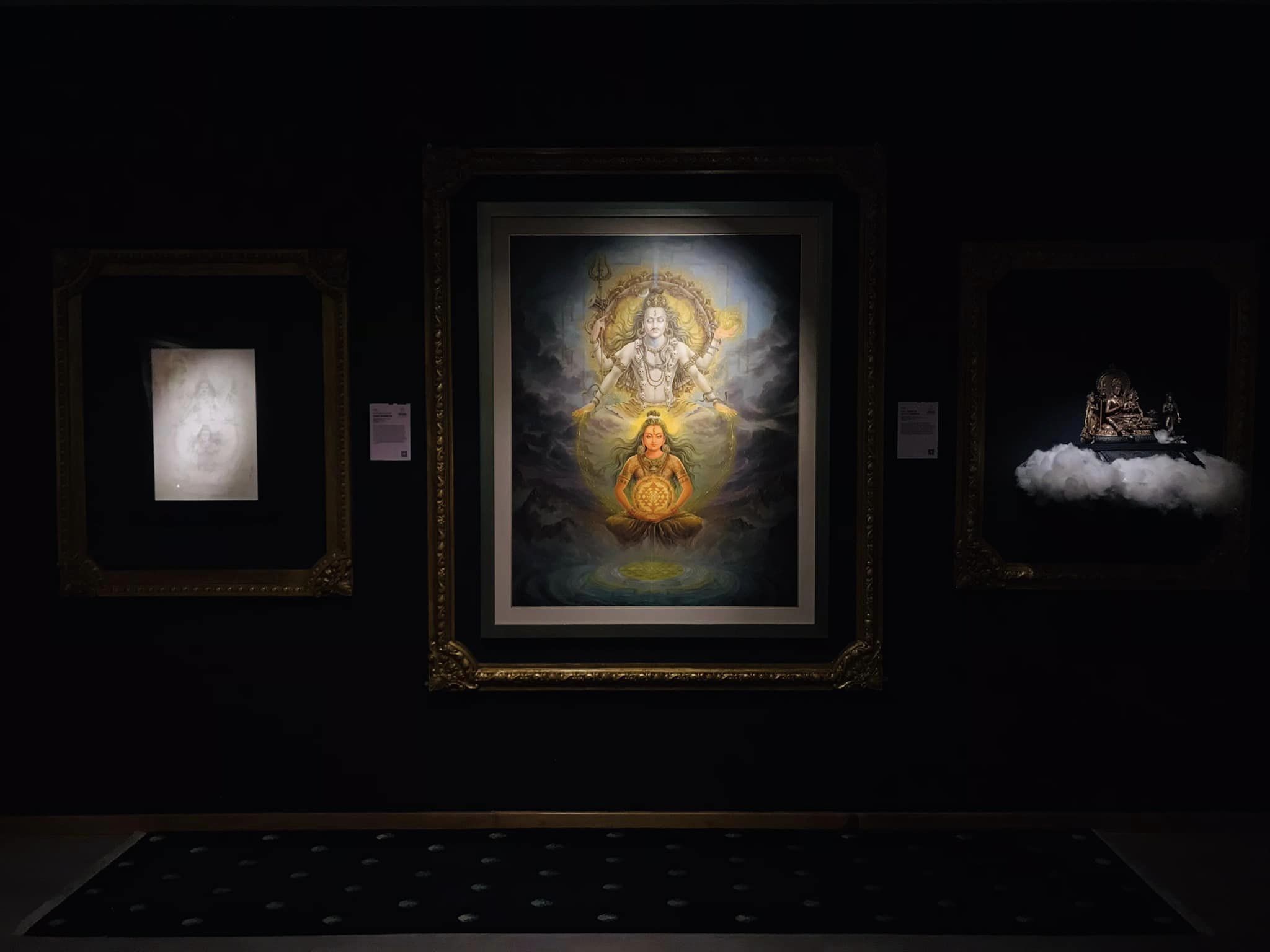 Artworks on display at Kathmandu Art Biennale, Spiritual Edition 2024 at Museum of Nepali Art (MONA), Thamel, Kathmandu. Photo: Krishna Gopal Shrestha
Artworks on display at Kathmandu Art Biennale, Spiritual Edition 2024 at Museum of Nepali Art (MONA), Thamel, Kathmandu. Photo: Krishna Gopal ShresthaWhat does spirituality mean to someone? Is it the pathway of life or is it the solution to get away from mundane life and have the illusion of being someone in control as life is all about uncertainty?
No matter the answer, there is no denying that spirituality has many meanings and it differs from one individual to another. The most common meaning of spirituality exists with the connection to the higher realm or being. Specifically, spirituality lies beyond one’s mind, body and soul that can drive a person towards positivity. It might be the reason why most of us have our version of spirituality and being an individual we have different preferences.
“For me spirituality is being empathetic and compassionate. I don’t find spirituality in religious devotions even being born in a Buddhist family. However, I find it in the teachings and art. When I am looking at art it gives me the feeling of peace,” says Ursula Manandhar, co-curator of Kathmandu Art Biennale.
Kathmandu Art Biennale, Spiritual Edition 2024, which kicked off on January 18 in Kathmandu is the first biennale in the country. At the biennale, one can get to experience different dimensions of spirituality through artworks.
While curating the biennale, Manandhar says got to understand different concepts of spirituality for artists. One such, striking concept of spirituality which she will never forget is by artist Abhijeet Prajapati. “In his conceptual art title Abhayankar, he intertwined his ego and religious motifs used in Paubha paintings,” says Manandhar. “His concept is impressive where he is pouring his ego into himself and for him, spirituality is understanding one’s ego and letting it work for betterment.”
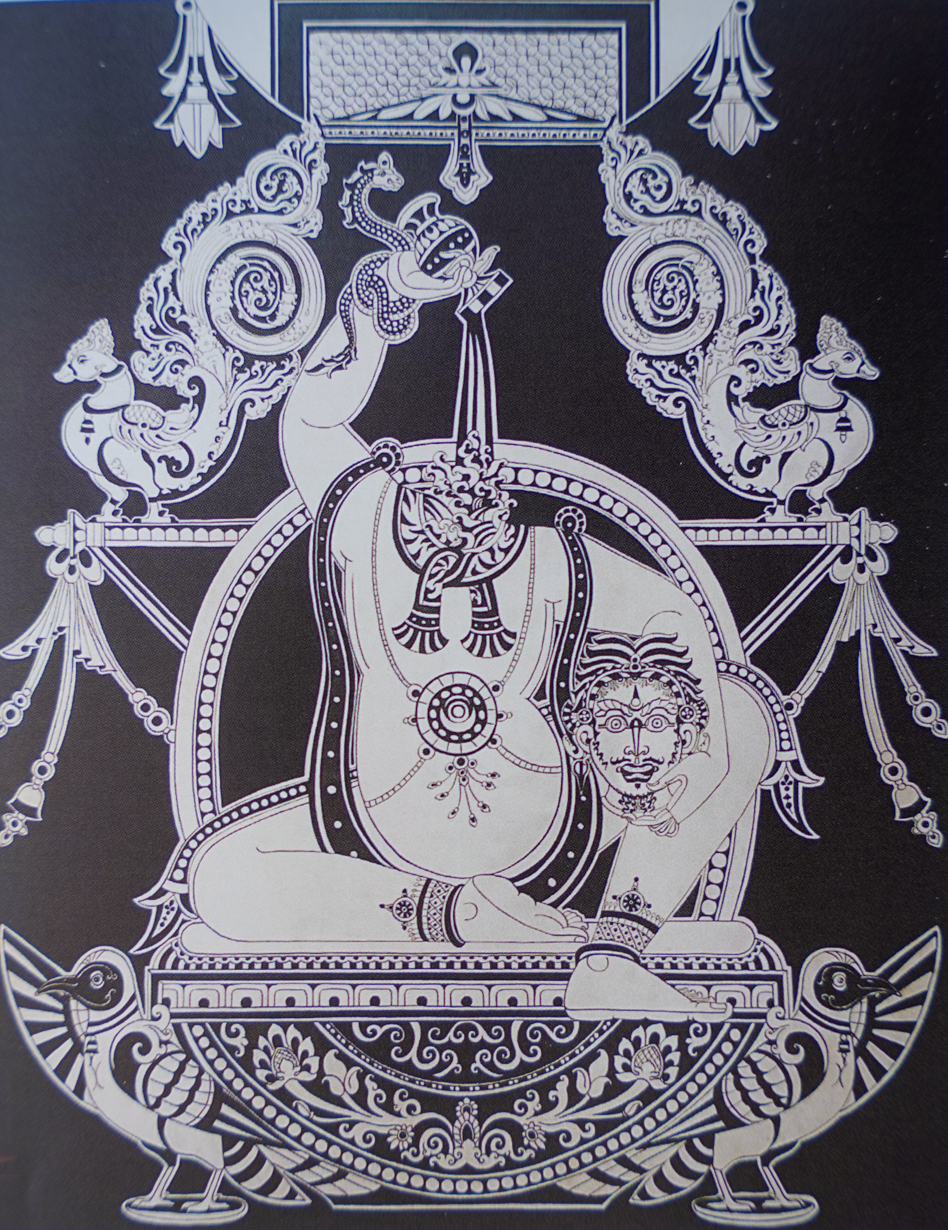 Artist Abhijit Prajapati’s conceptual art title Abhayankar, at Kathmandu Art Biennale Spiritual Edition 2024, MONA, Thamel, Kathmandu.
Artist Abhijit Prajapati’s conceptual art title Abhayankar, at Kathmandu Art Biennale Spiritual Edition 2024, MONA, Thamel, Kathmandu.In the painting titled ‘Abhijeet Ahankar=Abhihankar’, using natural pigment on cotton canvas in Paubha-style representation in black and white hues, artist Abhijeet featured a human figure in Rajalilasana. Rajalilasana is a type of sitting pose also known as a pose for a deity of luxury; the right leg is held vertically and the left is folded flat.
This figure is surrounded by decorative motives. He is sitting on a seat decorated with flower patterns and crows on each side. On the top, the figure of the peacock’s decorative motives has been used. On the left hand, the figure is holding his head and from the right hand, he is pouring liquid into the neck.
According to the artist, the painting is of the ego and has symbolic significance, contributing to understanding one’s identity. For him, spirituality involves understanding his emotions, thoughts and behaviours, he says, “The importance of self-awareness can be portrayed as a gateway to spirituality.”
Moreover, in the biennale, 79 Nepali artists have shared their meaning of spirituality through their art and are located in three different venues — Museum of Nepali Art (MONA), Kathmandu Guest House and Kathmandu Art House.
The biennale is organised by the Museum of Nepali Art and one can view 100 artworks, beautifully curated for the viewers to understand the creative artworks and delve into deeper meanings of spirituality. Additionally, one can get a different perspective on spirituality than one already has, which is expressed in authentic and creative ways through Paubha paintings, Thangka paintings, modern paintings, sculptures, printmaking, pen & ink and installations.
In the Biennale
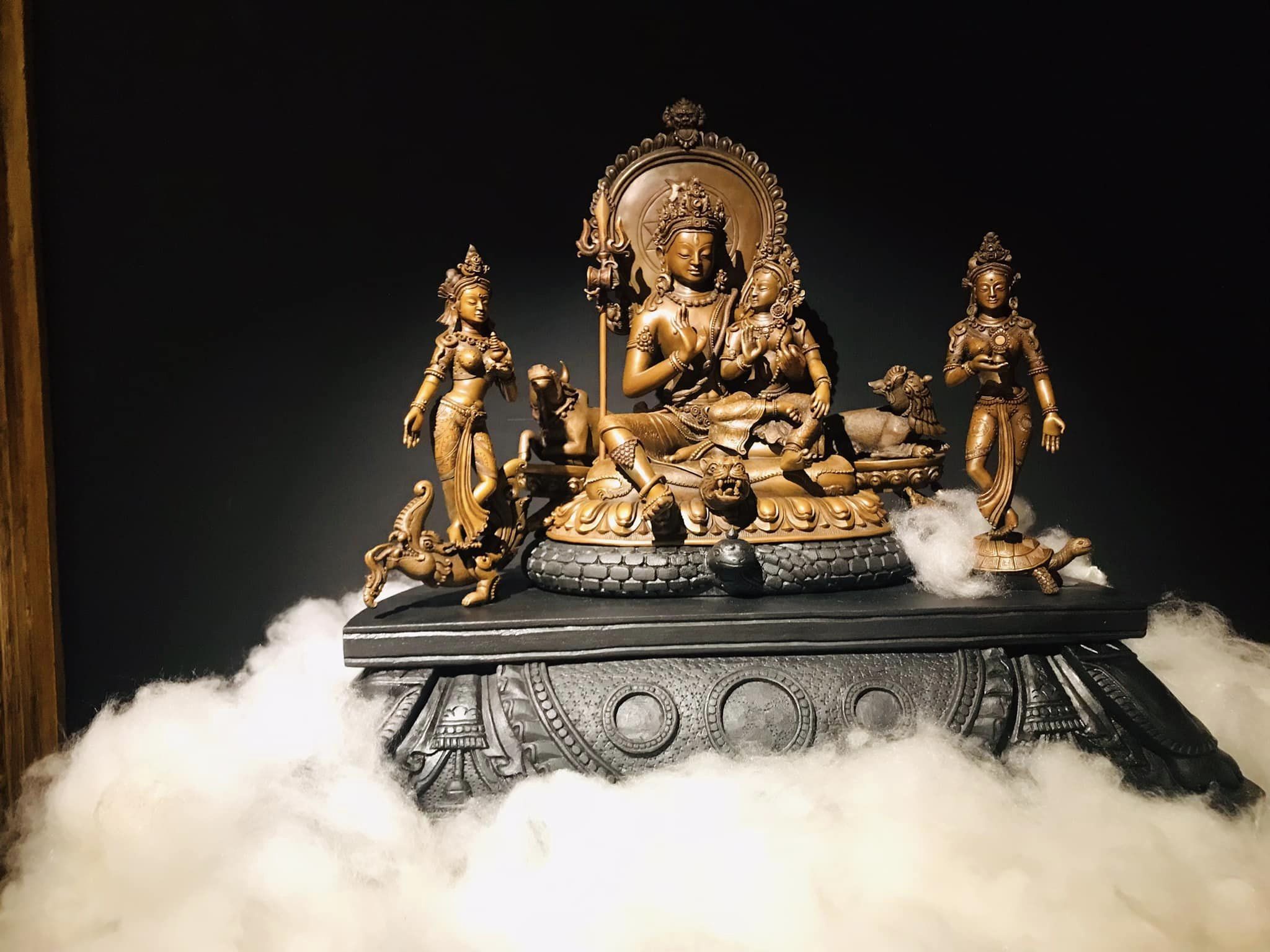 Metal statute titled Uma Maheshvar by artist Anil Shakya at Kathmandu Art Biennale, MONA, Thamel, Kathmandu. Photo: Krishna Gopal Shrestha
Metal statute titled Uma Maheshvar by artist Anil Shakya at Kathmandu Art Biennale, MONA, Thamel, Kathmandu. Photo: Krishna Gopal ShresthaThe Spiritual Edition 2024 has featured only Nepali artists. These artists were chosen by the MONA and it took around eight months give birth so such an event. The biennale targets to see 1,000 visitors per month.
The ticket is priced at Rs 500 and with that ticket, you are allowed to visit the biennale repeatedly within the exhibition period. The biennale consists of artworks from different generations of veteran artists like the late Tej Bahadur Chitrakar, Kiran Manandhar, Udaya Charan Shrestha, Sarada Man Shrestha, Purna Hyoju, Lok Chitrakar, Madan Chitrakar and more.
 Late Tej Bahadur Chitrakar’s painting ‘Ancestor at Work’ on display at Kathmandu Art Biennale, MONA, Thamel, Kathmandu.
Late Tej Bahadur Chitrakar’s painting ‘Ancestor at Work’ on display at Kathmandu Art Biennale, MONA, Thamel, Kathmandu.The biennale has included modern contemporary artists to traditional contemporary artists, which is curated at different venues. At the museum, the spirituality that relates to the divine and divinity along with the everyday link with its essence has been featured.
As such the first artwork that welcomes you is the self-portrait of the late artist Tej Bahadur Chitrakar along with the tools he used to create his artworks as a homage to the late artist. Tej Bahadur is a prominent figure who contributed to the development of the Nepali art fraternity. Next to it is the painting ‘Gyatri’ by Udhaya Charan Shrestha, a masterpiece created during his solo exhibition. Likewise, Samundra Man Singh’s painting of Lord Shiva and Goddess Parbati is placed next to the metal sculpture of Deities Uma Maheshwor by Anil Shakya and Suman Shakya, giving you a feeling of divinity in the exhibition.
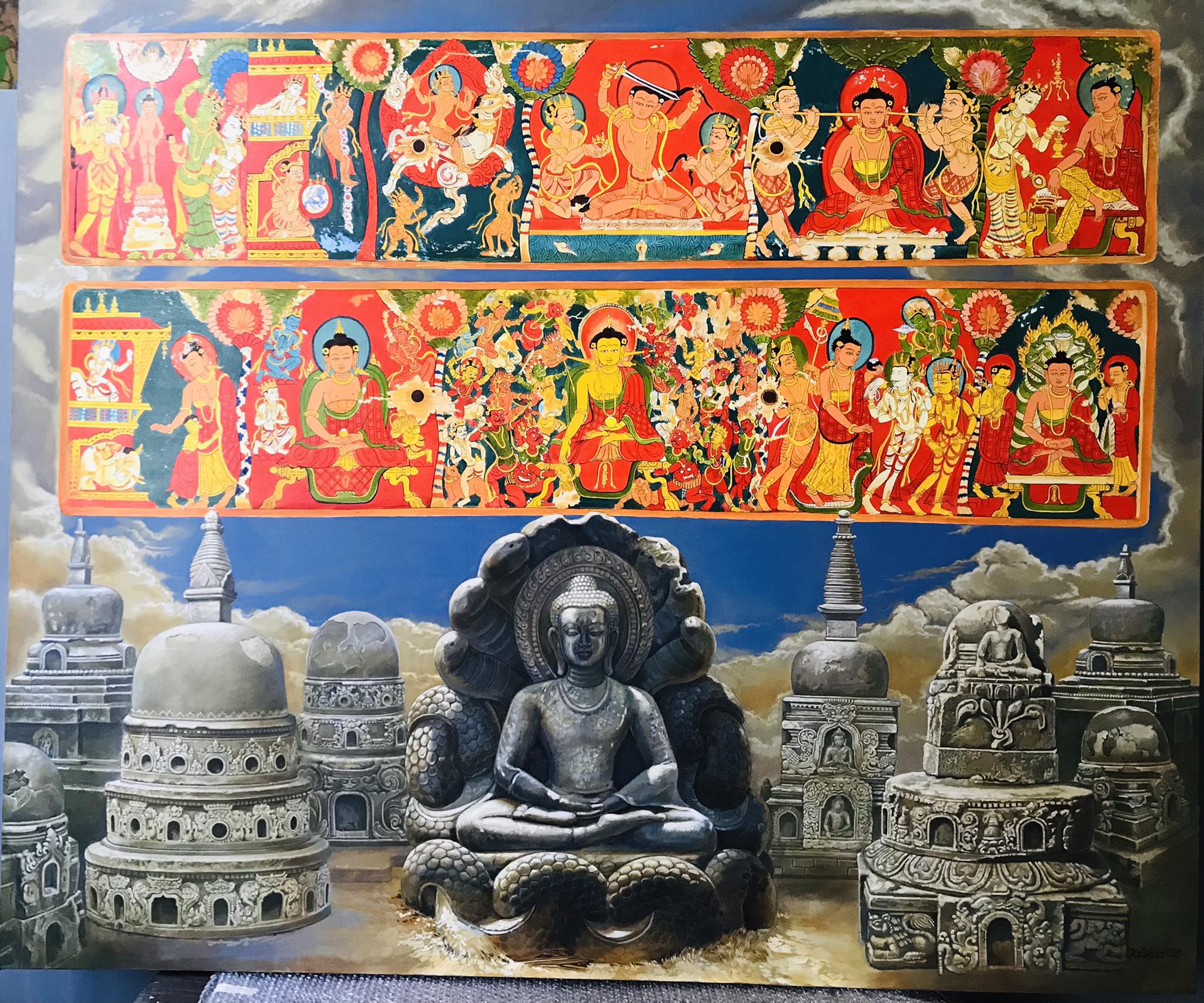 Painting by artist Krishna Gopal Shrestha at Kathmandu Art Biennale.
Painting by artist Krishna Gopal Shrestha at Kathmandu Art Biennale.Not only the Hindu gods and goddesses but you can also get to see Newa Buddhist and Tibetian Buddhist motifs in the museum. The curators have aptly utilised the chambers in the museum that have powerful messages and the techniques showcased by the artists are also unique.
There is a blend of religious aspects and practices that is prevalent in the Nepali community. At the end left corner of the museum, the artworks that showcase the spirituality of Kathmandu Durbar Square through the celebrations of Jatras, are displayed for the viewers. Artist Rajan Pant has beautifully placed the mask dancers that perform during Indra Jatra on the backdrop of outside Basantapur Durbar Square along with the placement of samay baji.
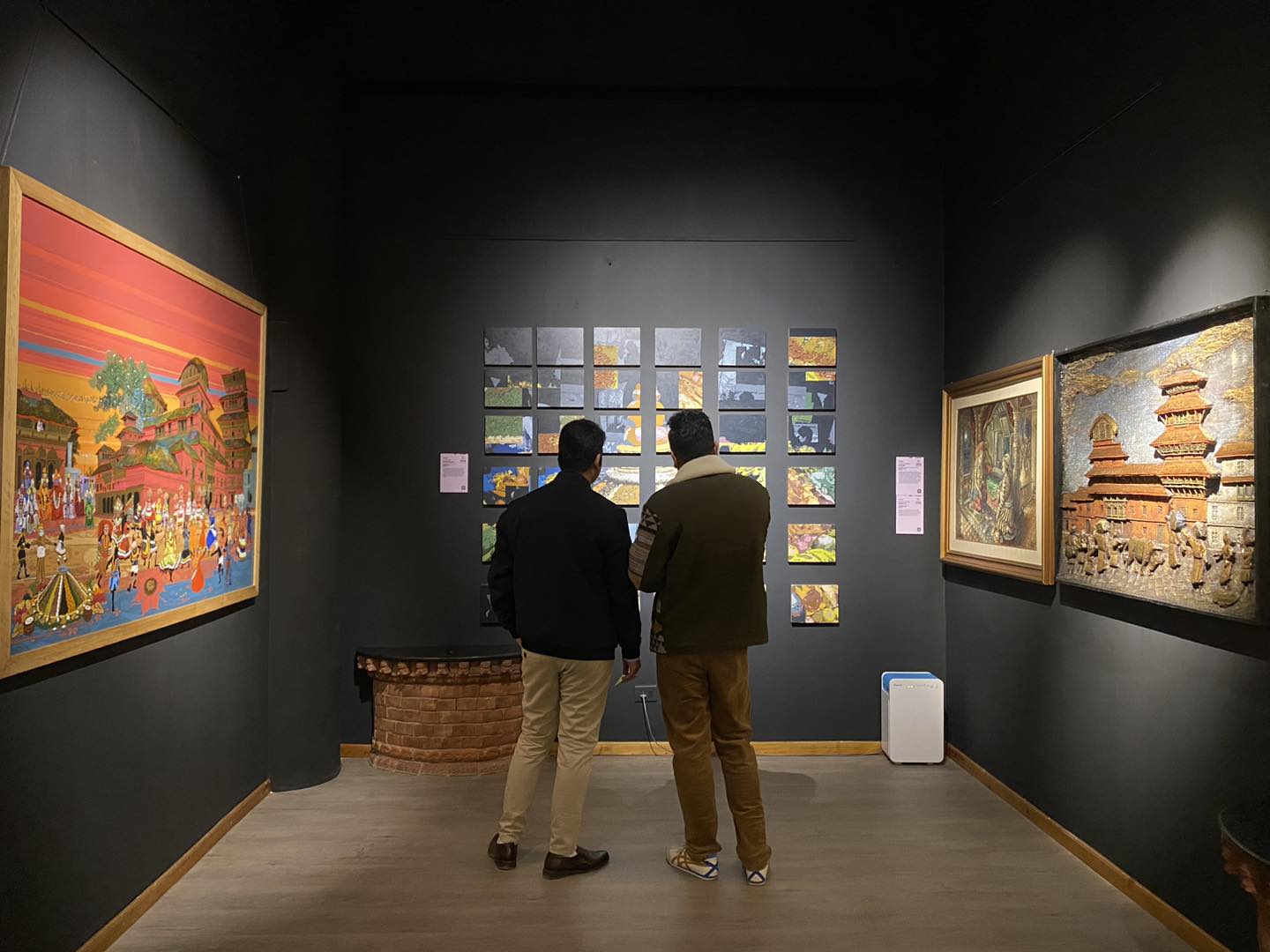 Visitors at Kathmandu Art Biennale at MONA, Thamel, Kathmandu.
Visitors at Kathmandu Art Biennale at MONA, Thamel, Kathmandu.Then, next to it, artist Sujan Bir Bajracharya’s abstract painting featuring samay baji is on display where food symbolises deeply connected cultural roots, spirituality and spirituality, particularly in the Kathmandu Valley.
In the same corner, a popular painting of Goddess Taleju Bhawani and King Jaya Prakash Malla playing a dice game by veteran artist, Hari Prasad Sharma is on display. Likewise, 2D art by Sarada Man Shrestha representing bullfighting inside Basantapur Durbar Square has been displayed.
In the biennale, one can get the feel of a connection and divinity through the motifs and themes used by these artists. In the museum, traditional religious motifs dominate the artworks while the artworks in the Art House are traditional and modern architecture, conceptual installations, sculptures, childhood memories, life in general, and individuality have been used.
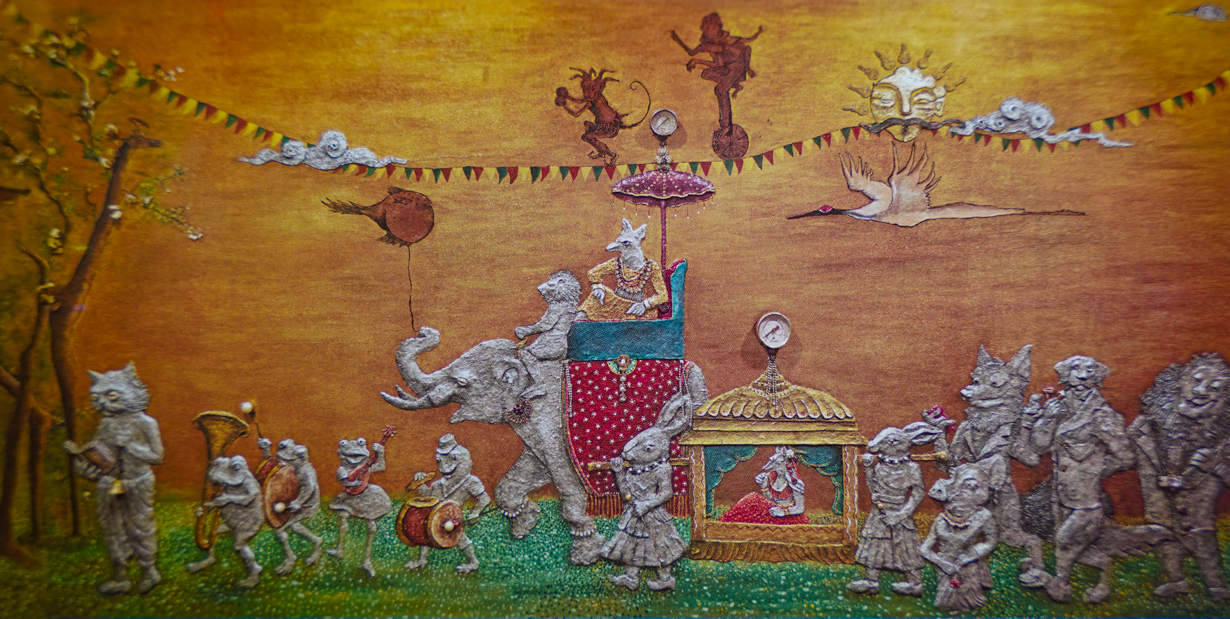 Artwork by artist Meena Kayastha at Kathmandu Art Biennale.
Artwork by artist Meena Kayastha at Kathmandu Art Biennale.Basanta Shrestha, former Director of Strategic Cooperation at the International Centre for Integrated Mountain Development (ICIMOD), who taking the tour of the Binnelae with his wife found it impressive.
 Artwork by artist Kiran Manandhar at Kathmandu Art Biennale. Photo: Krishna Gopal Shrestha
Artwork by artist Kiran Manandhar at Kathmandu Art Biennale. Photo: Krishna Gopal Shrestha“Through the Binnelae I found that these kinds of Nepali art can help to showcase the identity of Nepal in the world. This also gives an exposition of our true identity along with cultural values, spiritual values and social values, which have been reflected through their artworks,” says Shrestha, “I am also inclined to understand the spiritual heritage of Nepal. I think without the spiritual awakening of the artists, these sorts of mater pieces are not possible.”
A platform for networking and exposure
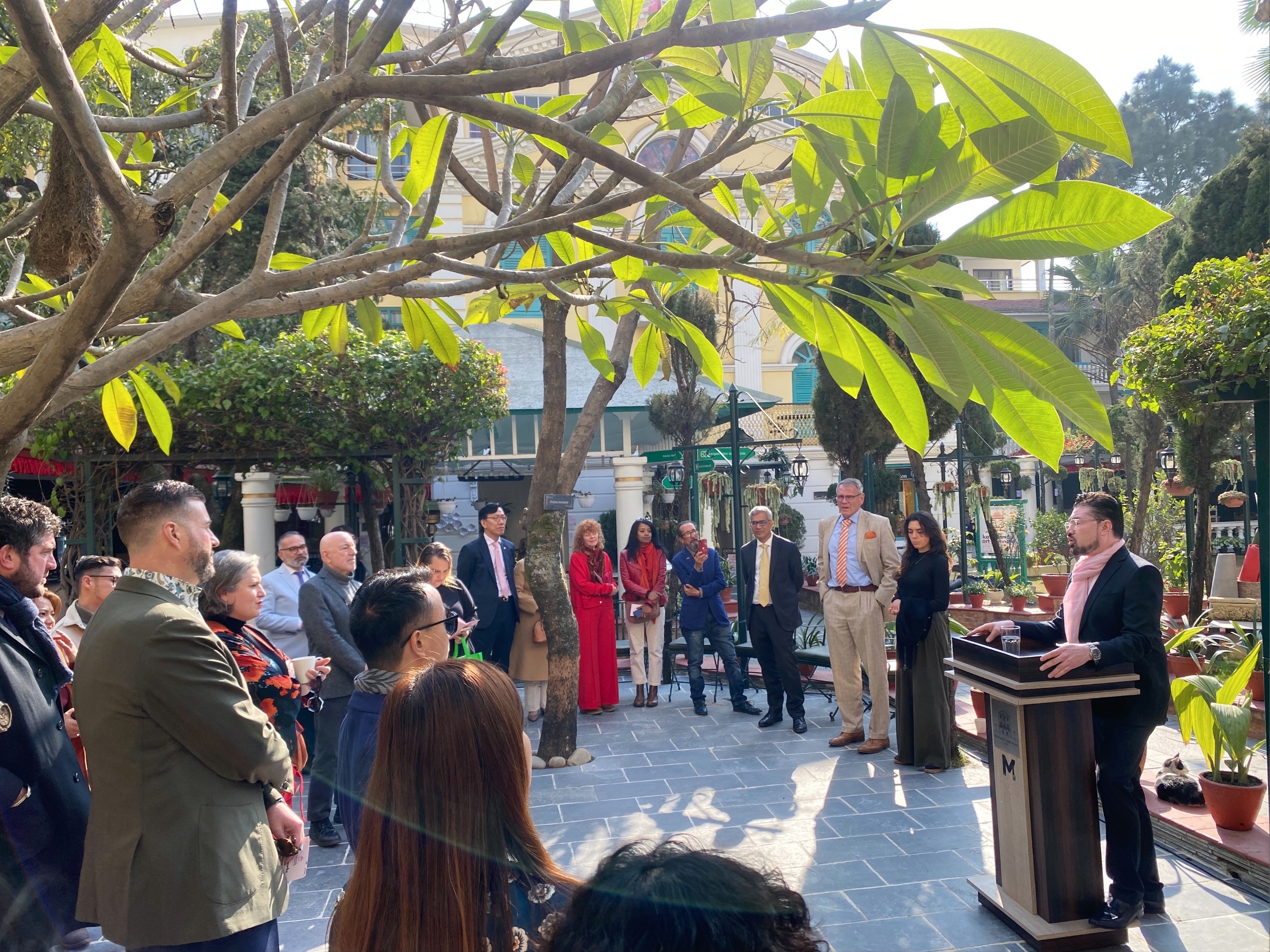 Artists, guests and organisers at Kathmandu Art Biennale, MONA, Thamel, Kathmandu.
Artists, guests and organisers at Kathmandu Art Biennale, MONA, Thamel, Kathmandu.The biennale has become a platform for artists to network and get exposure. Moreover, one can understand Nepali art scenarios in both traditional and modern contemporary Nepali art.
For artists like Manish Dhoju, the biennale has given him exposure along with a platform to network with audiences and artists. This is the first time he has exhibited his artwork in public. Dhoju used graphite and charcoal to create his masterpieces in hyperrealism, which resemble monochromatic photographs.
His artwork features the magnificent architecture of the Royal Gold Window and the mask of Vairab. He says, “In the biennale, I got to see impressive paintings by artists like Udaya Charan Shrestha and Samundra Man Shrestha. I am from an architect background and this has allowed me to meet the masters.”
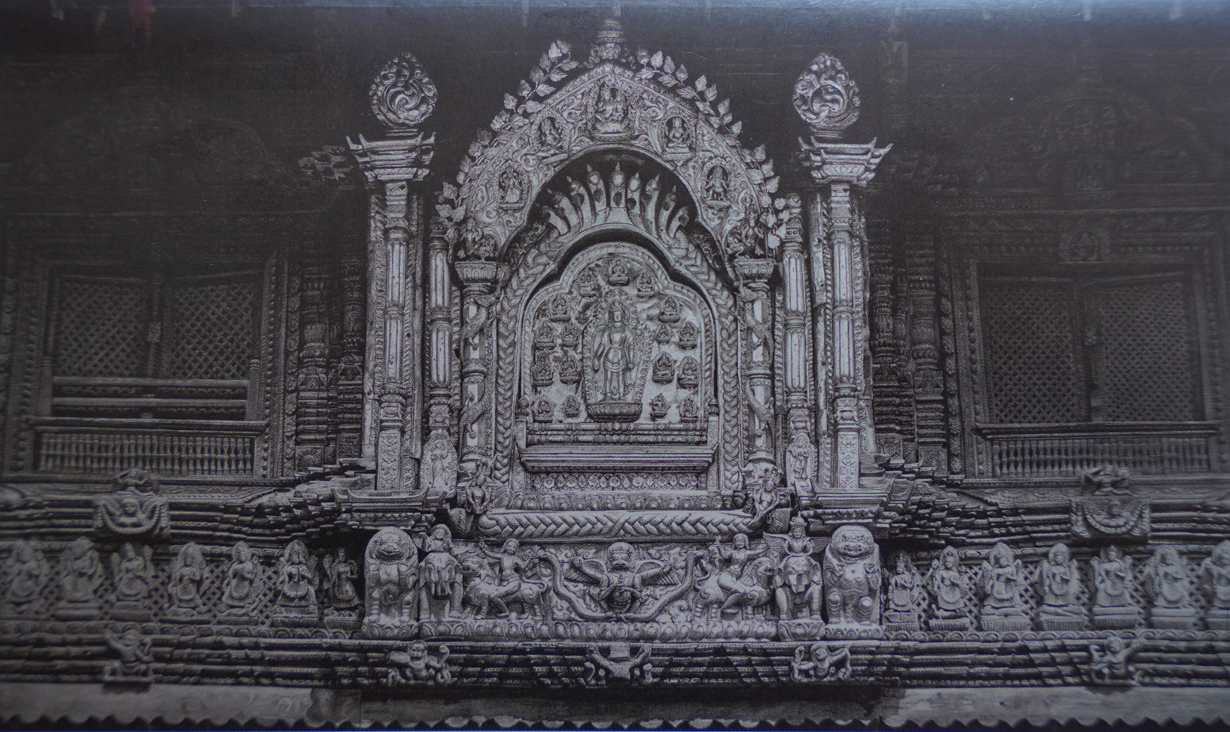 Hyperrealist artwork by Manish Dhoju using graphite and charcoal at Kathmandu Art Biennale, MONA, Thamel, Kathmandu.
Hyperrealist artwork by Manish Dhoju using graphite and charcoal at Kathmandu Art Biennale, MONA, Thamel, Kathmandu.According to Urusula, art curators and enthusiasts from Dubai, Australia and more have visited the biennale with the MONA’s invitation and they have shown hope for the Nepali artists in the artist’s meetups for international exposure.
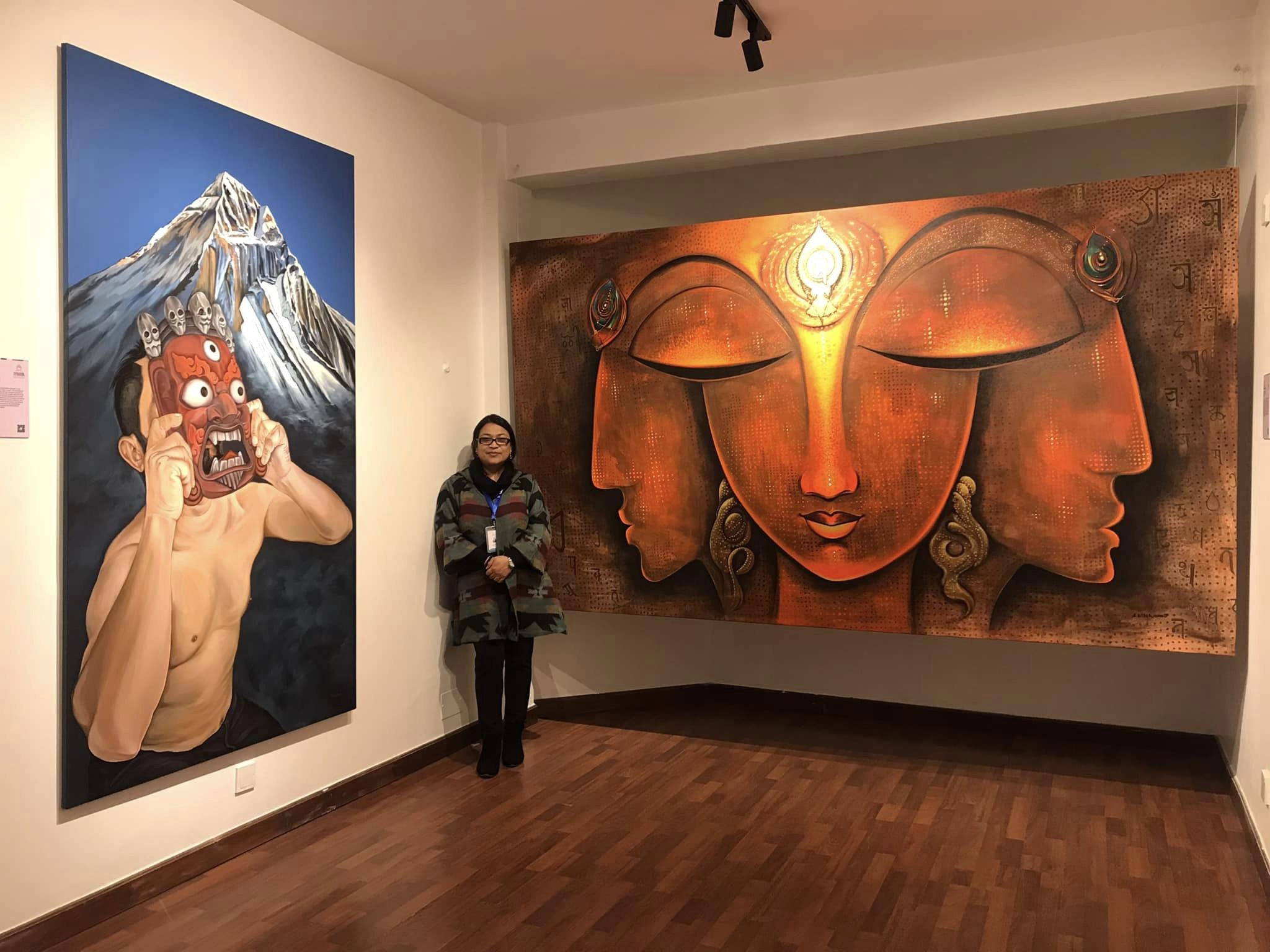 Artist Erina Tamrakar at the Kathmandu Art Biennale.
Artist Erina Tamrakar at the Kathmandu Art Biennale.Moreover, artist duo Asha Dangol and Erina Tamrakar too found the biennale as a hopeful event from the private sector with the enthusiasm to promote Nepali artists. “Kathmandu has already seen triennial and different art festivals. This biennale also adds up to developing Nepal as an art hub and helps to build international connections, which helps in commercial growth as well,” says Dangol.
One day would not be enough to understand the meaning of spirituality to these artists at the biennale and it is worth visiting it repeatedly as you get to experience something worthwhile. Rajan Sakya is the chief curator of the biennale and it is co-curated by Jenisha Maharjan, Ursula Manandhar and Rasna Shrestha, which continues till April 18.
.png)
 3 months ago
118
3 months ago
118








 English (US) ·
English (US) ·